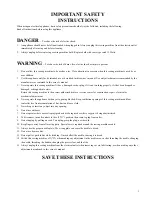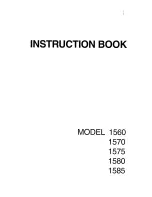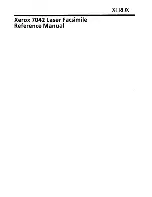
NAMES OF MACHINE PARTS AND THEIR FUNCTIONS
B-9
The names of the various parts of the sewing machine and their functions are described below. Before
using the sewing machine, carefully read these descriptions to learn the names of the machine parts.
Machine
■
Front View
a
Top cover
Open the top cover to thread the machine and wind the
bobbin.
b
Pre-tension disk
Pass the thread around the pre-tension disk when winding the
bobbin thread. (page B-38)
c
Thread guide for bobbin winding
Pass the thread through this thread guide when winding the
bobbin thread. (page B-38)
d
Spool pin
Place a spool of thread on the spool pin. (page B-46)
e
Spool cap
Use the spool cap to hold the spool of thread in place.
(page B-46)
f
Supplemental spool pin
Use this spool pin to wind the bobbin thread, or to sew with the
twin needle. (page B-38, B-49)
g
Bobbin winder
Use the bobbin winder when winding the bobbin. (page B-38)
h
LCD (liquid crystal display)
Settings for the selected stitch and error messages appear in
the LCD. (page B-22)
i
Speaker
j
Knee lifter
Use the knee lifter to raise and lower the presser foot.
(page S-15)
k
Knee lifter slot
Insert the knee lifter into the slot. (page S-15)
l
Operation buttons (7 buttons) and sewing speed
controller
Use these buttons and the slide to operate the sewing
machine. (page B-11)
m
Flat bed attachment with accessory compartment
Store presser feet and bobbins in the accessory compartment
of the flat bed attachment. When sewing cylindrical pieces,
remove the flat bed attachment. (page B-12)
n
Thread cutter
Pass the threads through the thread cutter to cut them.
(page B-48)
o
Thread guide plate
Pass the thread around the thread guide plate when threading
upper thread. (page B-46)
■
Right-side/Rear View
a
Connector for the optional presser foot
Connect the dual feed foot or embroidery foot with LED
pointer. (page B-60, B-67)
b
Handle
Carry the sewing machine by its handle when transporting the
machine.
c
Presser foot lever
Raise and lower the presser foot lever to raise and lower the
presser foot. (page B-53)
d
Air vent
The air vent allows the air surrounding the motor to circulate.
Do not cover the air vent while the sewing machine is being
used.
e
Main power switch
Use the main power switch to turn the sewing machine ON and
OFF. (page B-19)
f
Foot controller
Depress the foot controller to control the speed of the machine.
(page S-4)
g
Power cord receptacle
Insert the power cord into the machine receptacle. (page B-19)
h
Foot controller jack
Insert the foot controller plug into its jack on the machine.
(page S-4)
i
USB port for computer
In order to import/export patterns between a computer and the
machine, plug the USB cable into the USB port. (page B-65,
S-97, E-47)
j
USB port for mouse/media (USB 2.0)
In order to send patterns from/to USB media, plug the USB
media directly into the USB port. (page B-65, S-96, E-46)
Connect the USB mouse to operate with mouse. (page B-66)
k
Handwheel
Rotate the handwheel toward you (counterclockwise) to raise
and lower the needle. The wheel should be turned toward the
front of the machine.
NAMES OF MACHINE PARTS AND THEIR FUNCTIONS
Summary of Contents for 882-C53
Page 89: ...USEFUL FUNCTIONS Sewing Basics Sewing S 19 S 1 ...
Page 145: ...STITCH SETTING CHART Utility Stitches Sewing S 75 S 2 ...
Page 182: ...USING STORED CUSTOM STITCHES S 112 ...
Page 200: ...ATTACHING THE EMBROIDERY FRAME E 18 b Pull the embroidery frame toward you ...
Page 237: ...EMBROIDERY APPLICATIONS Embroidery Embroidering E 55 E 1 ...
Page 268: ...USING THE MEMORY FUNCTION E 86 ...
Page 311: ......












































